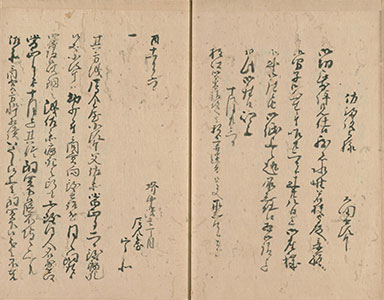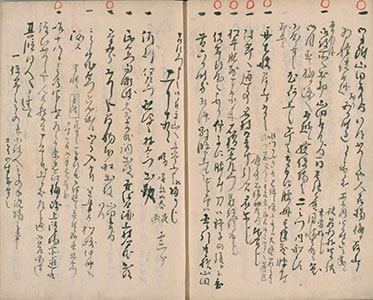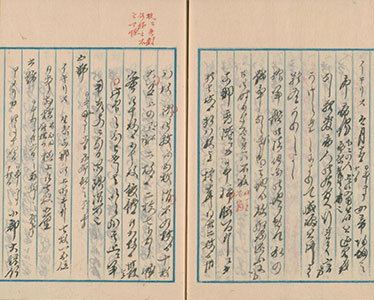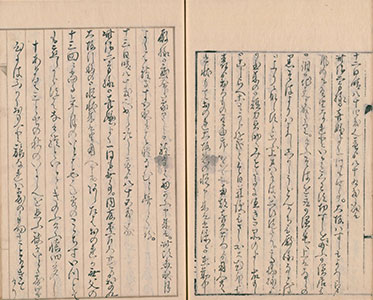Chapter 1 The statesmen and their entourage The officials
The officials
OTA Nampo, 1749-1823
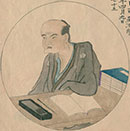 A gokenin (lowest-ranking direct vassal) of the Shogunate in the late Edo period. He used Naojiro as a common name, Nampo being his other pseudonym. He was also known by the name of Shokusanjin. Though Nampo is known for his works as a comic tanka poetry writer and a litterateur, his actual occupation was a minor official.
A gokenin (lowest-ranking direct vassal) of the Shogunate in the late Edo period. He used Naojiro as a common name, Nampo being his other pseudonym. He was also known by the name of Shokusanjin. Though Nampo is known for his works as a comic tanka poetry writer and a litterateur, his actual occupation was a minor official.
5 Doza goyodome, [1801][WA19-24]
A series of paperwork processed and copied by Nampo, who was appointed to the Osaka doza (copper mint of the Shogunate) in 1801. The record spans from March 15 to the last day of December of the same year. The inserted part shows the description of events such as the punishment of Kariganeya, who neglected procedures for the transfer of ownership of their inheritance (left side).![]()
6 Kaikei shiki, 1804[や-21]
A daily log of official duties kept during Ota Nampo’s appointment to Nagasaki. It contains articles from November 7 to the last day of December 1804.
Concurrently with Nampo’s arrival on Nagasaki, a Russian ambassador named Nikolay Petrovich Rezanov was also visiting the city under the national isolation. Corresponding to this event became the assignment for Nampo, which seems to be the reason why he marked Russia-related articles with “○”. The article of November 18 describes his meeting with Rezanov. Moreover, Nampo’s letter dated November 23 records that Rezanov had called him “Ota Naojiro”, nodded and shook his hand.
NINOMIYA Sontoku, 1787-1856
Namiko, 1805-1871
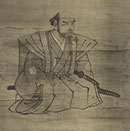 The leader of the agriculture restoration movement in the last days of the Shogunate, who was famous for his anecdote of continuing to read while he helped with housework by carrying firewood. In order to revive the worn-out agricultural community, Sontoku advocated land tax control as well as conserving and savings on the farmers’ side.
Namiko married Sontoku at the age of 16. She supported Sontoku along with their two children by taking care of people who came to him for help.
The leader of the agriculture restoration movement in the last days of the Shogunate, who was famous for his anecdote of continuing to read while he helped with housework by carrying firewood. In order to revive the worn-out agricultural community, Sontoku advocated land tax control as well as conserving and savings on the farmers’ side.
Namiko married Sontoku at the age of 16. She supported Sontoku along with their two children by taking care of people who came to him for help.
7-1 Toza kingin beisen deiricho, 1836[尊-大-132]
7-2 Toza kingin beisen deiri hikaecho, 1831[尊-大-126-3]
An account book from when Sontoku supervised the agricultural restoration in Sakuramachi, Shimotsuke Province (present Moka City, Tochigi Prefecture). The article dated August 25 shows the record of a person by the name of Jin’emon depositing money, written by Sontoku himself. The article of 27 shows the handwriting of his wife, Namiko, describing the receiving of the first harvested rice of the year sent from a person named Jintaro.
Waka poetry written on the reverse side of the front cover page, titled “Shobu”. The meaning of the poem is as follows: “You are beaten because you tried to beat someone, if you did not think about beating anyone, you will never be beaten”.

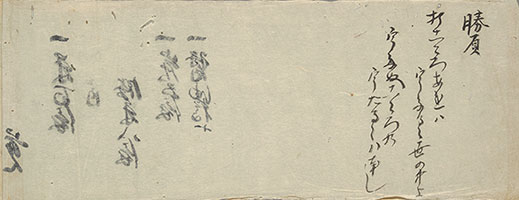
 Ninomiya Sontoku kankei shiryo
Ninomiya Sontoku kankei shiryo
Ninomiya Sontoku kankei shiryo consists of over 10,000 materials including Sontoku’s literary works and records of activities.
Ninomiya Sontoku zenshu (lit. Complete Works of Sontoku Ninomiya, published by Ninomiya Sontoku Igyo Sen’yokai, 1927-1932) was compiled using these materials as the original texts. It also includes dozens of materials in Sontoku’s handwriting.
KAWAJI Toshiakira, 1801-1868
Satoko, 1803-1884
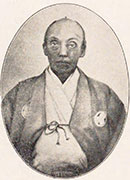 An official of the Shogunate at the end of the Edo period, in charge of foreign affairs with Russia. He committed suicide by himself concurrently with the collapse of the Shogunate regime. His wife, Satoko, was known for her beauty and intelligence. Record tells that Toshiakira once boasted to Evfimiy Vasil’evich Putyatin, the Russian ambassador, that she was “one of the most beautiful women, if not the best, in Edo”.
An official of the Shogunate at the end of the Edo period, in charge of foreign affairs with Russia. He committed suicide by himself concurrently with the collapse of the Shogunate regime. His wife, Satoko, was known for her beauty and intelligence. Record tells that Toshiakira once boasted to Evfimiy Vasil’evich Putyatin, the Russian ambassador, that she was “one of the most beautiful women, if not the best, in Edo”.
8-1 Sejo kikigaki, [ca. 1864][863-197]
A memorandum written by Toshiakira. The inserted part describes the episode of Queen Victoria’s visit to a hospital in the United Kingdom, which deeply moved all its patients. It also includes other articles such as the number of people arrested by Scotland Yard and the national expenditure of Spain.
8-2 Kawaji Satoko nikki, 1851[863-197]
The diary of Satoko during the time when Toshiakira served as a member of the Osaka City commissioners. For example, in the entry dated August 12, Satoko had noted that she has “heard that they have Edo-style sushi in Osaka, but has not had a chance to eat any”. The numbers at the beginning of the diaries are the temperature of the day. 89 degrees in Fahrenheit is about 32 degrees in Celsius.



